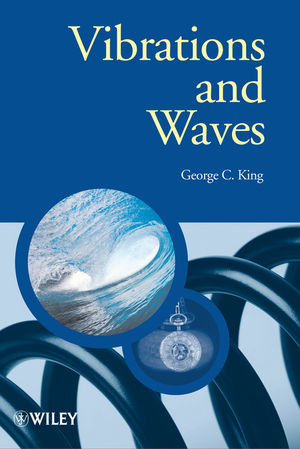Vibrations and WavesISBN: 978-0-470-01189-8
Paperback
248 pages
July 2009
 This is a Print-on-Demand title. It will be printed specifically to fill your order. Please allow an additional 10-15 days delivery time. The book is not returnable.
Other Available Formats: Hardcover
|
||||||
Editors' Preface to the Manchester Physics Series xi
Author's Preface xiii
1 SIMPLE HARMONIC MOTION 1
1.1 Physical Characteristics of Simple Harmonic Oscillators 1
1.2 A Mass on a Spring 2
1.2.1 A mass on a horizontal spring 2
1.2.2 A mass on a vertical spring 5
1.2.3 Displacement, velocity and acceleration in simple harmonic motion 5
1.2.4 General solutions for simple harmonic motion and the phase angle φ 7
1.2.5 The energy of a simple harmonic oscillator 10
1.2.6 The physics of small vibrations 12
1.3 The Pendulum 17
1.3.1 The simple pendulum 17
1.3.2 The energy of a simple pendulum 19
1.3.3 The physical pendulum 22
1.3.4 Numerical solution of simple harmonic motion3 24
1.4 Oscillations in Electrical Circuits: Similarities in Physics 27
1.4.1 The LC circuit 27
1.4.2 Similarities in physics 29
PROBLEMS 1 29
2 THE DAMPED HARMONIC OSCILLATOR 33
2.1 Physical Characteristics of the Damped Harmonic Oscillator 33
2.2 The Equation of Motion for a Damped Harmonic Oscillator 34
2.2.1 Light damping 35
2.2.2 Heavy damping 37
2.2.3 Critical damping 38
2.3 Rate of Energy Loss in a Damped Harmonic Oscillator 41
2.3.1 The quality factor Q of a damped harmonic oscillator 43
2.4 Damped Electrical Oscillations 46
PROBLEMS 2 47
3 FORCED OSCILLATIONS 49
3.1 Physical Characteristics of Forced Harmonic Motion 50
3.2 The Equation of Motion of a Forced Harmonic Oscillator 50
3.2.1 Undamped forced oscillations 50
3.2.2 Forced oscillations with damping 54
3.3 Power Absorbed During Forced Oscillations 60
3.4 Resonance in Electrical Circuits 64
3.5 Transient Phenomena 66
3.6 The Complex Representation of Oscillatory Motion 68
3.6.1 Complex numbers 68
3.6.2 The use of complex numbers to represent physical quantities 71
3.6.3 Use of the complex representation for forced oscillations with damping 74
PROBLEMS 3 74
4 COUPLED OSCILLATORS 77
4.1 Physical Characteristics of Coupled Oscillators 77
4.2 Normal Modes of Oscillation 78
4.3 Superposition of Normal Modes 81
4.4 Oscillating Masses Coupled by Springs 87
4.5 Forced Oscillations of Coupled Oscillators 93
4.6 Transverse Oscillations 96
PROBLEMS 4 99
5 TRAVELLING WAVES 105
5.1 Physical Characteristics of Waves 106
5.2 Travelling Waves 106
5.2.1 Travelling sinusoidal waves 109
5.3 The Wave Equation 112
5.4 The Equation of a Vibrating String 114
5.5 The Energy in a Wave 116
5.6 The Transport of Energy by a Wave 119
5.7 Waves at Discontinuities 121
5.8 Waves in Two and Three Dimensions 126
5.8.1 Waves of circular or spherical symmetry 130
PROBLEMS 5 133
6 STANDING WAVES 137
6.1 Standing Waves on a String 137
6.2 Standing Waves as the Superposition of Two Travelling Waves 144
6.3 The Energy in a Standing Wave 147
6.4 Standing Waves as Normal Modes of a Vibrating String 149
6.4.1 The superposition principle 149
6.4.2 The superposition of normal modes 150
6.4.3 The amplitudes of normal modes and Fourier analysis 153
6.4.4 The energy of vibration of a string 156
PROBLEMS 6 158
7 INTERFERENCE AND DIFFRACTION OF WAVES 161
7.1 Interference and Huygen’s Principle 161
7.1.1 Young’s double-slit experiment 163
7.1.2 Michelson spectral interferometer 170
7.2 Diffraction 172
7.2.1 Diffraction at a single slit 172
7.2.2 Circular apertures and angular resolving power 177
7.2.3 Double slits of finite width 179
PROBLEMS 7 181
8 THE DISPERSION OF WAVES 183
8.1 The Superposition of Waves in Non-Dispersive Media 183
8.1.1 Beats 184
8.1.2 Amplitude modulation of a radio wave 186
8.2 The Dispersion of Waves 187
8.2.1 Phase and group velocities 188
8.3 The Dispersion Relation 192
8.4 Wave Packets 195
8.4.1 Formation of a wave packet 197
PROBLEMS 8 201
APPENDIX: SOLUTIONS TO PROBLEMS 205
Index 223



